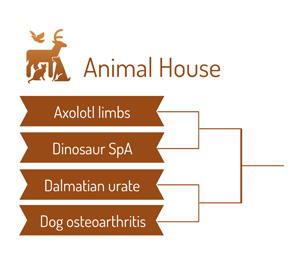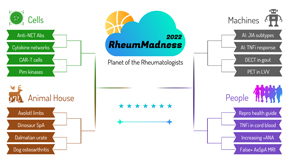 Editor’s note: RheumMadness is the place for everyone crazy about rheumatology to connect, collaborate, compete and learn together. During RheumMadness, rheumatology concepts represent teams that compete against each other in a tournament, much like basketball teams do in the NCAA’s March Madness tournament. In a series for The Rheumatologist, readers will get a chance to read the scouting reports for each concept team. These reports are written by rheumatology fellows from 13 programs throughout the U.S.
Editor’s note: RheumMadness is the place for everyone crazy about rheumatology to connect, collaborate, compete and learn together. During RheumMadness, rheumatology concepts represent teams that compete against each other in a tournament, much like basketball teams do in the NCAA’s March Madness tournament. In a series for The Rheumatologist, readers will get a chance to read the scouting reports for each concept team. These reports are written by rheumatology fellows from 13 programs throughout the U.S.
Don’t forget to submit your RheumMadness 2022 bracket by March 25. The more your picks match those of our Blue Ribbon Panel of rheumatologists, the more points you get. Learn more about the panel and how the brackets work online.
Connect with RheumMadness by subscribing to the podcast and joining the conversation on Twitter, #RheumMadness. Learn more on the RheumMadness website
Region: Animal House Team: Dinosaur Spondyloarthritis
Calling on our collective expertise acquired from a childhood fascination with dinosaurs, The Discovery Channel and high school biology, we present the following scouting report on spondyloarthropathy in the fossil record.
In the primary base article, researchers inspected the Perissodactyla (i.e., the horse and rhinoceros) fossil record, as represented at several institutions in North America, Europe and Africa, to estimate the prevalence of spondyloarthropathy.1 Findings of sacroiliac or zygapophyseal erosions or fusion or presence of syndesmophytes were diagnostic of spondyloarthropathy. Although some may consider a few potential threats to the accuracy of this diagnosis—recall bias, anyone?—and wish for a report of keratoderma blenorrhagicum or the worst case of onycholysis ever seen, it does seem the study authors did the best they could with what they had. Further, the authors note they could confidently exclude infectious etiologies due to the absence of certain distinctive skeletal changes.
 According to their reported results, rates of spondyloarthropathy seemed to progressively increase among Perissodactyla through each new epoch, with specimens from the Holocene—our current geologic period—having the highest rates. This trend correlated with an increase in the size of the animals, a relationship that has not been seen in other mammals with spondyloarthropathy. Amazingly, evidence of osteoarthritis in the fossil record was rarely observed.
According to their reported results, rates of spondyloarthropathy seemed to progressively increase among Perissodactyla through each new epoch, with specimens from the Holocene—our current geologic period—having the highest rates. This trend correlated with an increase in the size of the animals, a relationship that has not been seen in other mammals with spondyloarthropathy. Amazingly, evidence of osteoarthritis in the fossil record was rarely observed.
Horses, rhinos, what’s next? Dinos? How did you know? Yes, apparently Camarasaurus, a genus of quadrupedal, herbivorous dinosaurs, holds the record for the earliest known case of spondyloarthropathy—and, therefore, inflammatory arthritis—147 million years ago.2
Implications
As sickle cell is protective against Plasmodium, one must wonder if spondyloarthropathy once provided an evolutionary benefit. Were our grandfathers actually giving sage advice when they recommended we grow a spine?
In the animal kingdom, flexibility can come at a cost. More flexible joints and spines are more maneuverable. But more flexibility also opens the door to more injury (think Ehlers-Danlos syndrome and the like). Thus, it’s possible spondyloarthropathy may have provided musculoskeletal protection to various species. More research may be helpful in this regard.
Another line of thought considers disease etiologies. Human-centric environmental risk factors, such as smoking, oral health and contrived diets, have been implicated in the pathogenesis of rheumatoid arthritis, which is a much more recent disease that—as far as we know—only affects humans and their ancestral relatives. We can perhaps postulate that some well-established risk factors for spondyloarthropathy, such as sheer mechanical stress and reactive arthritis from sexually transmitted organisms, were so ubiquitous that no species was spared from spondyloarthropathy. One can only imagine how much reproduction was required in times of the unforgiving Jurassic world—and sadly no penicillin was lying around.
Chances in the Tournament
A perusal of Google’s finest artistic renditions of Chalicotheriidae may initially spur rapturous visions of defensive greatness sure to carry this team to win the tournament. It’s an interesting observation that spondyloarthropathy is an ancient form of arthritis shared across various orders and apparently classes of the animal kingdom. However, the vulnerability of the results to confounding and probable reduced direct application to human patients compared with other teams make it doubtful Dinosaur Spondyloarthritis will advance beyond the Final Four. This team could be a dark horse, though one that is hopefully not inflicted by inflammatory back pain.
David Shoemaker, MD, is a second-year rheumatology fellow in the Virginia Commonwealth University Rheumatology Fellowship Program, Richmond, Va.
Evan Dombrosky, MD, is a first-year rheumatology fellow in the Virginia Commonwealth University Rheumatology Fellowship Program, Richmond, Va.
Nima Madanchi, MD, is a second-year rheumatology fellow in the Virginia Commonwealth University Rheumatology Fellowship Program, Richmond, Va.
Abhishek Nandan, MD, is the associate program director of the Virginia Commonwealth University Rheumatology Fellowship Program, Richmond, Va.
Huzaefah Syed, MD, is the program director of the Virginia Commonwealth University Rheumatology Fellowship Program, Richmond, Va.
References
- Rothschild BM, Prothero DR, Rothschild C. Origins of spondyloarthropathy in perissodactyla. Clin Exp Rheumatol. Nov–Dec 2001;19(6):628–632.
- Rothschild BM. Spondyloarthropathy in the Jurassic. Lancet. 2002 Nov 9;360(9344):1454.
 Experience All of RheumMadness
Experience All of RheumMadness
During RheumMadness, rheumatology concepts represent teams that compete against each other in a tournament, much like basketball teams do in the NCAA’s March Madness tournament. In a series for The Rheumatologist, readers will get a chance to read the scouting reports. Check out the reports from each region:
Region: Cells
Region: Animal House
Region: Machines
Region: People
• False Positive MRI in Axial SpA
Don’t forget to submit your RheumMadness 2022 bracket by March 25. The winner of each match-up is decided by a seven-member Blue Ribbon Panel of rheumatologists. The panel will vote based on which topic they think is most important to patients, providers and researchers—both now and in the future. The more your picks match those of the panel, the more points you get. The tournament results will be released in four rounds from March 26–April 4. Prizes will be given to participants with the top scores in the following categories: 1) attending/APP, 2) fellow and 3) resident/medical student. The prize is a custom RheumMadness coffee mug and a lifetime of bragging rights.
Connect with RheumMadness by subscribing to the podcast and joining the conversation on Twitter, #RheumMadness. Learn on the RheumMadness website.



